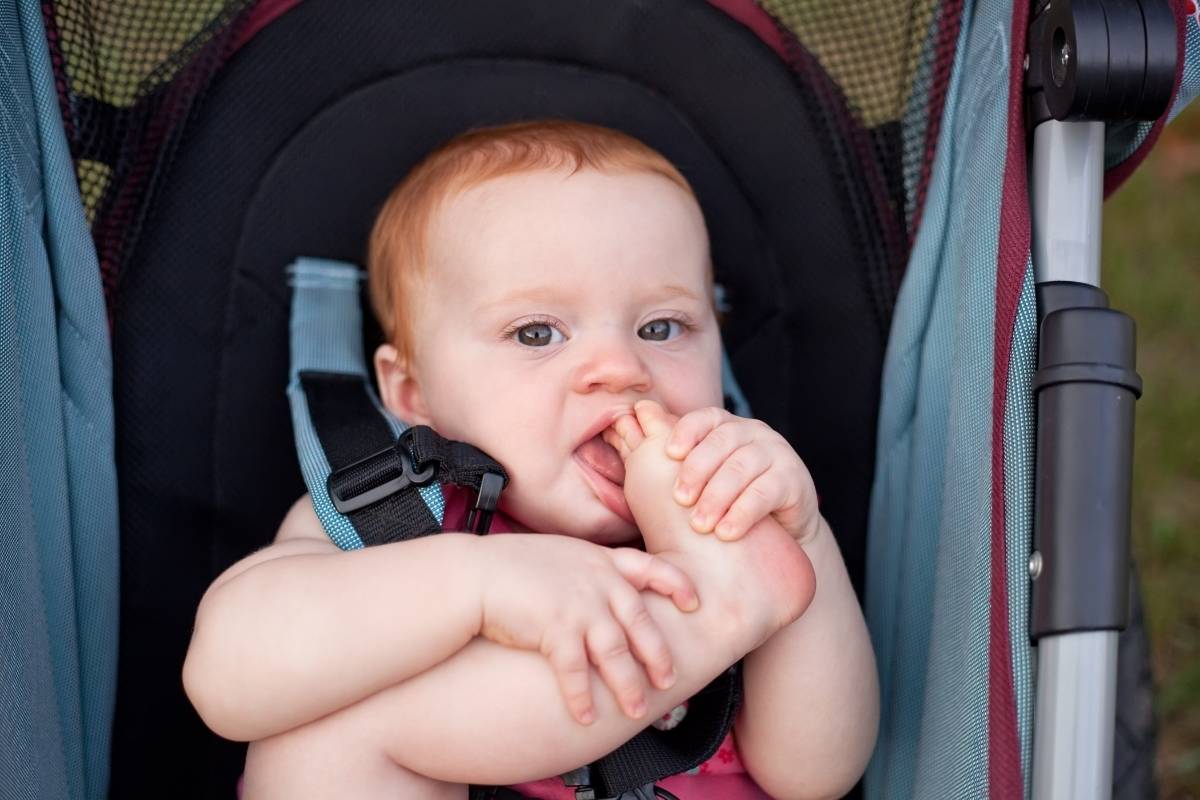
If you’ve ever played with an infant, you’ll certainly agree with me that babies are very flexible. In case you don’t know, the flexibility in babies includes the ability to stretch and bend without stress. Because of the nature of their bones, babies can always twist and wriggle into various positions without feeling any pains.
But here’s a burning question,
Why Exactly Are Babies So Flexible?
Generally, toddlers are pretty flexible because of the nature of their bones. According to studies, babies are often born with about 300 smaller bones (that’s about 94 bones more than those of adults). These bones are flexible cartilages, which are very soft, elastic, and tough. This explains why babies are so flexible.
Why are babies more flexible than adults? How long exactly will the flexibility last in toddlers? What is hypermobility and how bad is it? These are some of the frequently asked questions that you’ll find answers to as you read through the rest of this article.

Why Are Babies More Flexible Than Adults?
Many factors contribute to why babies are naturally more flexible than adults. One of them is the nature of the bones in babies.
According to studies, a toddler’s body has about 300 small soft bones at birth. The interesting part of that is – these bones tend to fuse as the baby grows up and becomes an adult. This explains why an adult’s body only has about 206 bones, instead of the usual 300 bones that come with babies at birth.
As mentioned above, the 300 small soft bones in the body of a baby are made of flexible cartilage. What I’m trying to say is that the bones aren’t exactly bones. Instead, they are soft and elastic cartilage, which eventually turns into strong bones as the baby grows older.
That said, one way to explain the flexibility of babies is that their bones are made of soft, flexible, and elastic cartilages. Toddlers are more flexible than adults because they only have elastic cartilages in their bodies, which takes a long time to turn to actual bones. This is also one of the reasons why a baby can only lie flat for the first 6 months.
Here’s What You Need To Know About Cartilages
In case you don’t know, cartilages are thin, fibrous, flexible connective tissues that are usually found in some parts of an adult’s body, such as the external ear, larynx, and respiratory tract. This explains why you (as an adult) can twist your ear without feeling any pain.
In the adult body, the cartilages found in the external ear and respiratory tract lack blood vessels; this explains why the growth and development of the cartilages are very low.
As you already know, a baby’s body has over 300 bones. Some of these bones are made of flexible cartilage. These soft and elastic bones, over time, will develop into strong bones with the help of calcium. The presence of blood vessels, which circulate blood throughout the body as the baby grows, is another factor that aids the development of the cartilage into strong bones.
Here’s How The Changing Of Bones Occurs As Babies Grow
As your baby continues to grow, many of the cartilages in its body starts to fuse and turn to actual strong bones. The fusing of cartilages occurs throughout the body of your toddler when tiny blood vessels (capillaries) start to circulate blood around the bones.
Here’s how the blood vessels help in building up the bones;
- The production of blood vessels in structures outside the embryo often starts about fifteen to sixteen days after fertilization. Two days after, blood vessels production begins within the embryo. Furthermore, the production of the capillaries continues after birth.
- In babies, capillaries function by helping to circulate blood to various parts of the body, including the cells that form the bones (Osteoblasts)
- As the Osteoblasts receive blood, it begins to form bones, which end up replacing the elastic cartilage in your baby’s body.
- At each end of bones in toddlers, there are growth plates, where bone growth occurs.
- In each growth plate, there’s a tissue, which helps to determine the shape and size of the bone.
- The growth plate continues to open and remain active as the kid continues to grow. It only stops working and closes when a person stops growing.

Ligaments And Muscles Are Other Factors
Apart from the elastic cartilage in a baby’s body, there are a couple of factors that contribute to why babies are usually more flexible than adults. One of them is because the toddlers’ muscles haven’t yet developed to the stage where they are capable of providing additional stability.
“Stretchy ligaments,” also known as ligamentous laxity, is another factor that contributes to why babies are usually more flexible than adults. In case you don’t know, ligamentous laxity, according to WebMD, means that a baby has hypermobile joints, which are usually very flexible.
Bottom line: a couple of factors contribute to why babies are so flexible than adults. One of them is the nature of the bones in toddlers’ bodies – they are made of soft, flexible, and elastic connecting tissues, called cartilage. Apart from that, another reason why babies are flexible is that they lack well-developed muscles, which could help to provide additional stability to support their bodies. Ligamentous laxity is the last factor that causes flexibility in babies.
What Is Hypermobility And Is It Bad?
In the previous section of this post, I mentioned that ligamentous laxity means that a toddler has hypermobile joints. But here’s a quick question, what exactly is hypermobility, and how bad can it be?
Hypermobility syndrome happens when a baby has extreme flexibility that mostly leads to pain. Don’t get it wrong; a baby can have extreme flexibility without feeling any pain. In this case, the baby is safe and there’s nothing to be worried about.
However, if your baby feels a lot of pain as a result of extreme flexibility, this is called hypermobility syndrome. Furthermore, hypermobility can be caused by several different factors; one of them, which I already mentioned earlier, is stretchy ligaments or ligamentous laxity. Ligamentous laxity is usually a result of the imbalance in protein fibers.
Other common causes of hypermobility in toddlers include the shape of the baby’s bone, the strength or tone of the muscle, and proprioception.
The Bad Side Of Hypermobility
Hypermobility syndrome, in most cases, could affect toddlers in a couple of ways. One of its common, as you already know, is pain (back pain and chest pain). Apart from that, hypermobility could also lead to headaches, flat feet, and general weakness of the baby’s ankles.
Here Are The Solutions For Hypermobility Syndrome
One of the effective ways to help your toddlers address the issue of hypermobility is by putting them through regular exercise. This way, you’ll be able to help them strengthen their muscles, especially those around the joints.
Another way to address the issue is by pairing some custom foot orthotics, which are uniquely made for your baby’s feet, with good supportive shoes. This way, you’ll be able to maximize your baby’s comfort and stability at its ankles.
Lastly, you can address hypermobility syndrome by enrolling your toddler in personalized rehabilitation programs. These programs could help improve your baby’s joint strength and stability.
How Long Exactly Will The Flexibility Last In Toddlers?
As you now know, babies are so flexible because of the nature of their bones, the strength of the muscles, and the conditions of their ligaments. This flexibility tends to reduce as the baby’s body starts to develop.
As your baby continues to grow, the soft cartilages will slowly start to fuse and turn into strong bones. The muscles will continue to develop to the stage where they can provide additional stability to the body. As this continues and the baby becomes an adult, the flexibility will reduce.
But here’s a quick question; for how long exactly will the flexibility last?
For most kids, flexibility could last for up to 10 years after birth. At this stage, the cartilage would have developed into strong bones. This happens as the protein collagen in the connecting tissue becomes less flexible. In addition to this, the muscles would also have developed enough to restrict excessive movement (flexibility).
You need to understand that your baby can remain flexible of ever. This will mostly happen if the baby has hypermobility without any pains involved.
Bottom line: flexibility in most babies only last for ten years before it starts to reduce. Furthermore, flexibility, for some babies, is something that could last for a lifetime without any harm.

